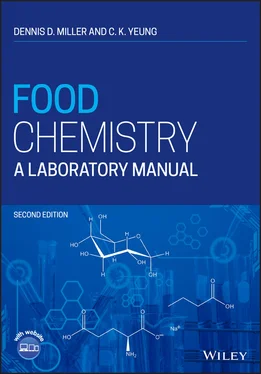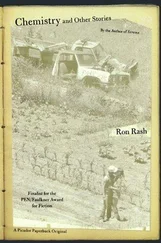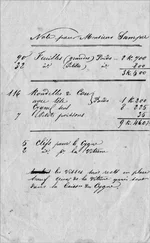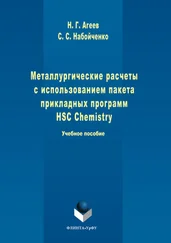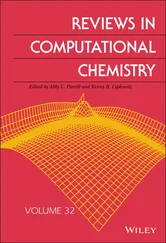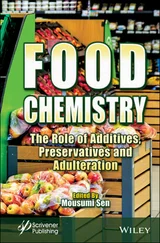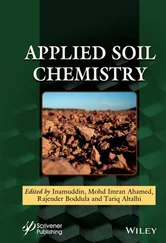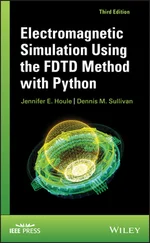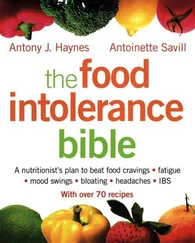Dennis D. Miller - Food Chemistry
Здесь есть возможность читать онлайн «Dennis D. Miller - Food Chemistry» — ознакомительный отрывок электронной книги совершенно бесплатно, а после прочтения отрывка купить полную версию. В некоторых случаях можно слушать аудио, скачать через торрент в формате fb2 и присутствует краткое содержание. Жанр: unrecognised, на английском языке. Описание произведения, (предисловие) а так же отзывы посетителей доступны на портале библиотеки ЛибКат.
- Название:Food Chemistry
- Автор:
- Жанр:
- Год:неизвестен
- ISBN:нет данных
- Рейтинг книги:3 / 5. Голосов: 1
-
Избранное:Добавить в избранное
- Отзывы:
-
Ваша оценка:
- 60
- 1
- 2
- 3
- 4
- 5
Food Chemistry: краткое содержание, описание и аннотация
Предлагаем к чтению аннотацию, описание, краткое содержание или предисловие (зависит от того, что написал сам автор книги «Food Chemistry»). Если вы не нашли необходимую информацию о книге — напишите в комментариях, мы постараемся отыскать её.
A manual designed for Food Chemistry Laboratory courses that meet Institute of Food Technologists undergraduate education standards for degrees in Food Science Food Chemistry: A Laboratory Manual
Food Chemistry: A Laboratory Manual
Food Chemistry — читать онлайн ознакомительный отрывок
Ниже представлен текст книги, разбитый по страницам. Система сохранения места последней прочитанной страницы, позволяет с удобством читать онлайн бесплатно книгу «Food Chemistry», без необходимости каждый раз заново искать на чём Вы остановились. Поставьте закладку, и сможете в любой момент перейти на страницу, на которой закончили чтение.
Интервал:
Закладка:
7 Measure the final pH of the solution in the filter flask.
2.5.1.4 Data Analysis
Note: A spreadsheet program will save you time on this exercise.
1 For each data point, subtract the control value from the treatment value.
2 Determine the total available CO2 in each of the treatments (express as moles of CO2). Assume that the baking powder contains 28% sodium bicarbonate.
3 Determine the moles of CO2 evolved at each time point. (You will need to use the ideal gas law to calculate the moles of CO2.) Transform your data to % of total available CO2.
4 Plot %CO2 evolved vs time for each of the treatments. Your plot should be similar to Figure 2.1. Be sure to indicate on your plot the point where you put the flask into the 65 °C bath.
2.5.2 Chemically Leavened Biscuits
2.5.2.1 Biscuit Formula
| Ingredients | Amount |
|---|---|
| All‐purpose flour | 100 g |
| Sugar | 6 g |
| Sodium bicarbonate | 1 g |
| Leavening acid | To be calculated a |
| Salt | 1.5 g |
| Oil | 23 g |
| Skim milk | 80 ml |
aUse the appropriate neutralizing values to calculate the amount.
Source: Adapted from [11].
2.5.2.2 Treatments
1 Control 1 (no leavening acid and no sodium bicarbonate)
2 Control 2 (1 g sodium bicarbonate but no leavening acid)
3 Fast‐acting leavening acid (use monocalcium phosphate monohydrate)
4 Slow‐acting leavening acid (use sodium aluminum sulfate)
5 Double‐acting leavening acid (use a 50 : 50 mixture of MCP monohydrate and SAS).
6 Baking powder (3.8 g), no sodium bicarbonate.
2.5.2.3 Protocol
1 Mix the dry ingredients thoroughly in a mixing bowl.
2 Add the milk, and oil and mix thoroughly (use 16 strokes) with a rubber spatula.
3 Measure out 65 g aliquots of the dough and place on a baking sheet. Make sure there is 1‐inch separation between each biscuit.
4 Bake at 218 °C (420 °F) for 15 minutes.
5 Cool down.
6 Compare volumes (see below) and textures of the various treatments.
7 Calculate the density of each biscuit.
2.5.2.4 Volume Determination of Biscuits
1 Select a plastic container (e.g. margarine tub or yogurt carton) slightly larger than the biscuit.
2 Fill the container level full with fine seeds (rapeseed or millet).
3 Pour seeds in the container into a graduated cylinder and record volume.
4 Place the biscuit in the empty container and refill with seeds.
5 Measure the volume of the seeds and calculate the volume of the biscuit by difference.
2.6 Problem Set
Note: These problems are designed to help you review concepts from introductory chemistry. Consult your introductory chemistry textbook for review.
1 Calculate the volume (at 25 °C and 1 atmosphere) of available CO2 contained in 0.34 g NaHCO3.
2 Explain why leavening rates differ between leavening acids.
3 The bicarbonate ion contains a proton and yet bicarbonate acts as a base in most leavening systems. Explain why this is so.
4 Why are double‐acting baking powders more effective in many baking applications than single‐acting baking powders?
5 The recipe for a large batch of pancake batter specifies 1 pound of baking soda and MCP as the leaving acid. How much MCP should be used?
6 Vinegar contains about 5% acetic acid (wt/vol). Calculate the normality of vinegar. What volume of vinegar would be required to neutralize 100 ml of 0.1 N sodium hydroxide?
7 You are baking a batch of biscuits and are out of baking powder. You decide to improvise and use vinegar and baking soda. You decide to add 2 teaspoons of baking soda to your dough. What volume of vinegar will you use? Assume that 1 mole of acetic acid will neutralize 1 mole of baking soda. One teaspoon of baking soda weighs 5 g.
8 The published neutralizing value of monocalcium phosphate monohydrate (MCP) is 80. Calculate the expected NV of monocalcium phosphate monohydrate based on stoichiometric relationships. Assume that the MCP is behaving as a monoprotic acid in this system. Does your result agree with the measured value of 80? If not, give a possible explanation. Note: To solve this problem, you will need to write balanced equations for the reactions between MCP and sodium bicarbonate (one with MCP acting as a monoprotic acid and the other with MCP acting as a diprotic acid).
9 What volume of CO2 would be produced from the complete neutralization of 5 g sodium bicarbonate at 80 °C?
10 Draw the structure of potassium acid tartrate. Write an equation to show why it is a leavening acid.
11 What is the main leavening acid in cultured buttermilk? Draw its structure.
12 What is the main leavening acid in lemon juice? Draw its structure.
13 Explain how glucono‐delta‐lactone can act as a leavening acid.
14 What is the minimum percentage of sodium bicarbonate in baking powder necessary to yield 12 g of CO2 per 100 g of powder? (Assume that all of the bicarbonate is converted to CO2 and H2O.)
15 What volume of 1.0 molar sulfuric acid would be required to neutralize 100 ml of 1.0 molar sodium hydroxide?
2.7 Useful Formulas and Values
1 Ideal gas law:PV = nRTwhere: P = pressure in atmospheres (atm)V = volume in liters (l)n = number of moles of gasR = 0.0821 (l) (atm) (mol−1) (K−1)T = temperature in K
2 Volume of 1 mole of CO2 under standard conditions = 22.40 l.
3 Standard temperature and pressure for gases: T = 273 K; P = 1 atm.
4 Baking soda content of baking powder: 28% NaHCO3 (w/w).
5 Formula weight of NaHCO3 = 84.01.
6 Molecular weight of CO2 = 44.0.
2.8 References
1 1 Van Wazer, J.R. and Arvan, P.G. (1954). Chemistry of leavening. Milling Production February–March: 3–7.
2 2 Heidolph, B.B. (1996). Designing chemical leavening systems. Cereal Foods World 41 (3): 118–126.
3 3 Gardner, W.H. (1966). Food Acidulants . Allied Chemical. 185 p.
4 4 Lindsay, R.C. (2017). Food additives. In: Fennema’s Food Chemistry , 5e (eds. S. Damodaran and K.L. Parkin ), 803–864. Boca Raton: CRC Press,Taylor & Francis Group.
5 5 McGee, H. (2004). On Food and Cooking: The Science and Lore of the Kitchen . Completely rev. and updated. New York: Scribner. 884 p.
6 6 AACC method 2‐32 A (1995). Neutralizing value of acid‐reacting materials. In: Approved Methods of the AACC , 9e. St. Paul, MN: The American Association of Cereal Chemists.
7 7 Book, S.L. and Waniska, R.D. (2015). Leavening in flour tortillas. In: Tortillas (eds. L.W. Rooney and S.O. Serna‐Saldivar ), 159–183. St. Paul, MN: AACC International Press.
8 8 Bellido, G.G., Scanlon, M.G., Sapirstein, H.D., and Page, J.H. (2008). Use of a pressuremeter to measure the kinetics of carbon dioxide evolution in chemically leavened wheat flour dough. Journal of Agricultural and Food Chemistry 56 (21): 9855–9861.
9 9 Kichline, T.P. and Conn, T.F. (1970). Some fundamental aspects of leavening agents. Bakers Digest 44 (4): 36–40.
10 10 Conn, J.F. (1981). Chemical leavening systems in flour products. Cereal Foods World 26 (3): 119–123.
11 11 Penfield, M.P. and Campbell, A.M. (1990). Experimental Food Science , 3e. San Diego: Academic Press. 541 p. (Food science and technology).
2.9 Suggested Reading
1 Labaw, G.D. (1982). Chemical leavening agents and their use in bakery products. Bakers Digest. 56 (1): 16.
2 Robinson, J.K., McMurry, J., and Fay, R.C. (2019). Chemistry , 8e. Hoboken, NJ: Pearson Education, Inc. 1200 p.
Читать дальшеИнтервал:
Закладка:
Похожие книги на «Food Chemistry»
Представляем Вашему вниманию похожие книги на «Food Chemistry» списком для выбора. Мы отобрали схожую по названию и смыслу литературу в надежде предоставить читателям больше вариантов отыскать новые, интересные, ещё непрочитанные произведения.
Обсуждение, отзывы о книге «Food Chemistry» и просто собственные мнения читателей. Оставьте ваши комментарии, напишите, что Вы думаете о произведении, его смысле или главных героях. Укажите что конкретно понравилось, а что нет, и почему Вы так считаете.
